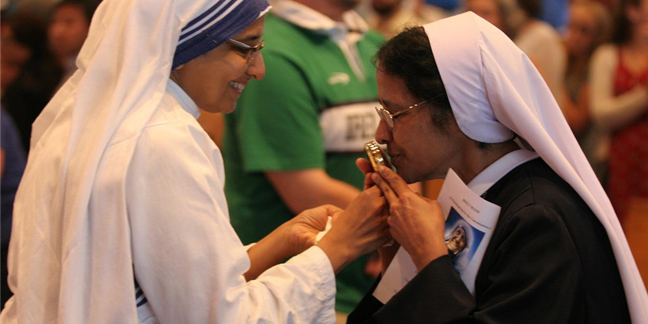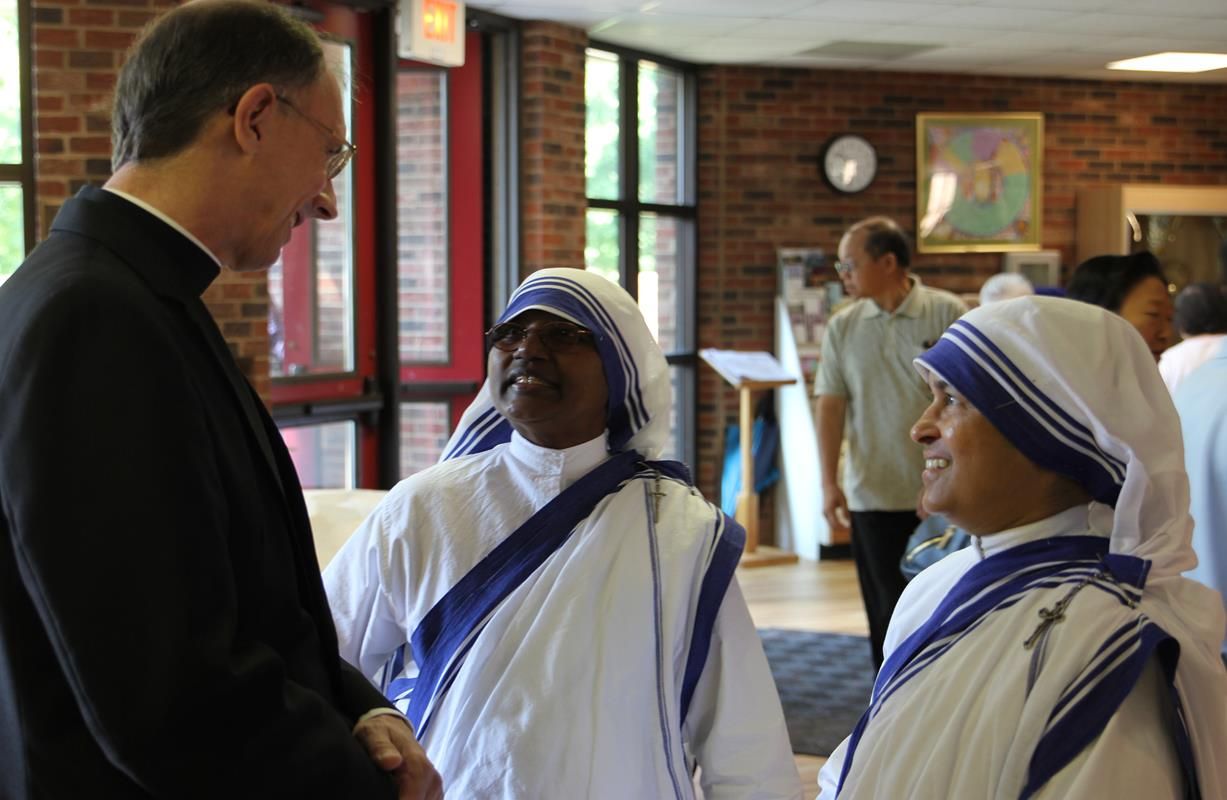‘This is the greatest event in the history of our society’
 CHARLOTTE — Sister M. Shilanand, M.C., and the three other Charlotte Missionaries of Charity sisters were bursting with joy as they greeted hundreds of guests for Mass Sept. 5 at Our Lady of the Assumption Church to commemorate their beloved St. Teresa of Calcutta on her inaugural feast day as a saint of the Church.
CHARLOTTE — Sister M. Shilanand, M.C., and the three other Charlotte Missionaries of Charity sisters were bursting with joy as they greeted hundreds of guests for Mass Sept. 5 at Our Lady of the Assumption Church to commemorate their beloved St. Teresa of Calcutta on her inaugural feast day as a saint of the Church.
“For me personally and for the sisters, all of us here, this is the greatest event in the history of our society,” Sister Shilanand, superior of the Charlotte convent, said. “We are so grateful to God for what He was able to do through her and in her.”
Bishop Peter J. Jugis and Bishop Emeritus William G. Curlin were warmly received by the sisters as they entered the narthex to prepare for Mass. Bishop Curlin worked with St. Teresa of Calcutta to bring the Missionaries of Charity to Charlotte more than 20 years ago. He was a close friend, confidante and confessor of the newly proclaimed saint. He served as homilist at Mass.
Bishop Jugis, who celebrates Mass for the Missionaries of Charity in Charlotte as his schedule allows, served as the main celebrant. More than 13 priests concelebrated the Mass.
During his homily on St. Teresa of Calcutta, Bishop Curlin drew laughter and sympathetic nods from the standing-room-only congregation as he shared Mother Teresa’s wisdom and challenged those gathered to look inside themselves for answers to some of the issues that plague our world today.
“Mother Teresa certainly deserves a great and wonderful homily,” Bishop Curlin said. “If you don’t mind, I’d like to reminisce about the days I was privileged to be with her to share her friendship here on earth.”
He described their meeting when he was a young priest recently moved to the poor parish of St. Mary’s Church in Washington, D.C. His cardinal told him there was “a little sister from India” he wanted him to meet. Arrangements had been made for him to meet with her the following Tuesday, but Mother Teresa came to Mass at St. Matthew Cathedral the Sunday before which he celebrated and asked to speak with him then instead.
“I put her in my car and drove her to my parish. As we began talking, I kept running to the front door every hour or so. She asked me what I was doing. I said, ‘Mother, I make sandwiches at night and I stack them in the refrigerator and people come all day long… I said, ‘What else can you give?’ She said, ‘You give them your heart.’ That’s social action. You give them your heart.
“The more she talked about her way of serving and of loving people, especially those hurting, I thought, ‘This is certainly a holy woman.’”
Bishop Curlin described how their friendship grew as they exchanged notes and phone calls, discussing spiritual matters.
He drew laughter from the congregation when he relayed how Mother Teresa got him to India the first time.
“One day she said to me, ‘I’ll see you next Wednesday.’ I said, ‘Oh wonderful, you’re coming to Washington.’ She said, ‘You’re coming to India.’ I told her, ‘Mother, I work in Baltimore and can't come to India. She said, ‘You’ll come,’ and put the phone down. A priest friend paid my way and I thought, ‘Good heavens, she’s a dictator!’”
Bishop Curlin recalled the valuable life experiences he gained during his trips to see Mother Teresa and the sisters in India.
“Going to India was some of the happiest times in my life. I saw things there… Poverty, I knew poverty from my area (in D.C.) but I had never seen poverty like that. People lying in the streets with rats, people starving.
“The sisters were helping them. What an inspiration it was to me. What an education in Christianity.”
He had the experience of bathing lepers and blessing people who were dying whom the Missionaries of Charity had welcomed into their centers to die with dignity. During his time there, Mother Teresa encouraged him to look with his heart and see Jesus in those to whom he ministered.
“Is that the way we live our life?” Bishop Curlin asked. “Do we see Jesus all around us? In the people that we like or people who sometimes hurt us? Do we see Jesus in the face of that person? That was the secret, I think, of Mother’s great life.
“She believed that you are the living presence of Jesus. When you are feeding a poor, hungry man or are washing a leper, trying to reach out with love to them, those are Christ’s hands. When you speak with kindness and forgiveness and understanding, you echo His heart. When you look at someone, you look with the kindness of Jesus.
“Or do we just say, ’I go to church and I’ve done my duty?’”
Bishop Curlin said Mother Teresa challenged him with the idea of rising above and really helping people, to see that it was Christ really trying to help people. “Do you really believe that Christ lives in us?” he similarly challenged those gathered.
He shared that he cherishes the memory of all the times he and Mother Teresa met and their spiritual conversations over the years. “Each time I went there, I realized I received more and more than I was able to offer that saint.”
Sister Shilanand said that Mother Teresa was specific about how she would help others if she were to become a saint.
“I remember what she said: ‘If I will be a saint, I will be one of darkness. I will be continually absent from heaven because I want to help. I want to come back to light the light of those who live in darkness.’
“My message to all of us is that we ask for her intercession. She has promised she will come to help us.”
— SueAnn Howell, senior reporter



















